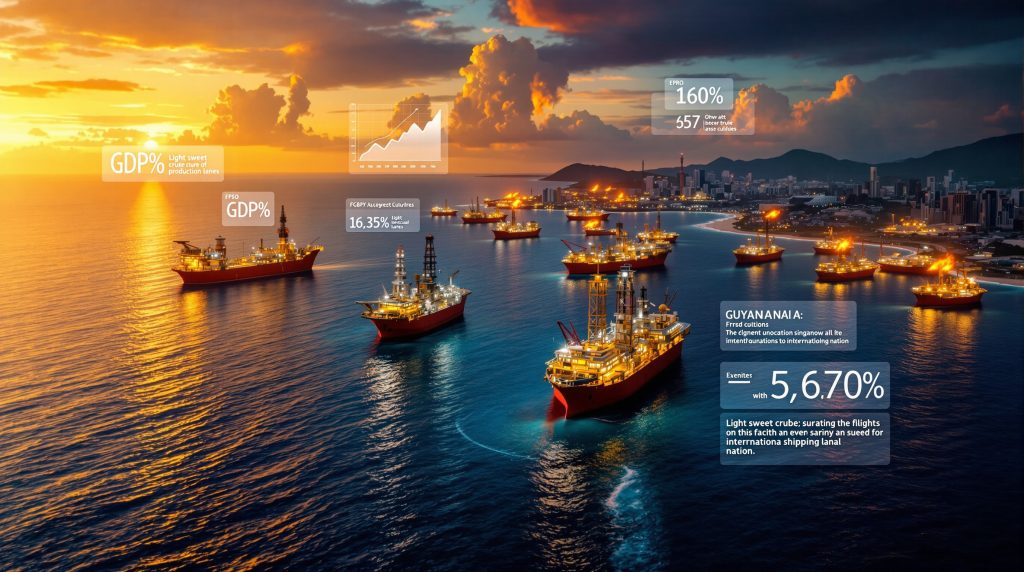How Did Guyana Become a Petroleum Powerhouse?
Guyana's transformation from an agricultural economy to an emerging petroleum giant represents one of the most dramatic economic shifts in recent global history. Since the first commercial extraction in December 2019, this small South American nation has experienced unprecedented growth in its offshore oil sector, catapulting it into the ranks of significant global producers in just a few years.
The discovery of massive offshore reserves in the Stabroek Block has positioned Guyana as a prime example of how natural resource discoveries can rapidly reshape a nation's economic trajectory. With production volumes increasing at a remarkable pace and substantial infrastructure developments underway, Guyana stands at a critical juncture in its development story.
The Scale of Guyana's Petroleum Discoveries
The Stabroek Block, spanning approximately 6.6 million acres offshore Guyana, has yielded over 11 billion barrels of oil equivalent in recoverable resources since initial exploration. This represents one of the largest oil discoveries globally in the past decade, particularly significant for a country with a population of less than 800,000 people.
The sheer magnitude of these discoveries has attracted substantial international investment and positioned Guyana to become one of the world's highest per-capita oil producers—a remarkable transition for a nation that previously relied heavily on agriculture, mining, and foreign aid.
What Makes Guyana's Oil Resources Unique?
Exceptional Geological Characteristics
Guyana's offshore oil fields possess several distinctive geological characteristics that enhance their commercial viability:
| Feature | Description | Impact |
|---|---|---|
| Reservoir Quality | High-porosity sandstone formations | Facilitates efficient extraction with strong flow rates |
| Oil Composition | Primarily light, sweet crude | Commands premium prices and requires less processing |
| Water Depth | Moderate deepwater conditions (1,500-2,000m) | Accessible with current technology while avoiding ultra-deepwater challenges |
| Field Size | Multiple large-scale discoveries | Enables economies of scale in development |
These favorable geological conditions have contributed to the rapid development timeline and attractive economics of Guyana's offshore projects, with production costs estimated to be significantly lower than many other frontier oil regions globally.
Strategic Geographic Position
Guyana's location on South America's northeastern coast provides strategic advantages for oil export logistics:
- Proximity to major Atlantic shipping lanes
- Direct access to North American and European markets
- Sheltered from hurricane zones that affect Gulf of Mexico operations
- Potential regional hub status for broader Caribbean energy infrastructure
These geographical advantages enhance the marketability of Guyana's crude oil and support its competitive position in global markets.
How Rapidly Has Guyana's Oil Production Grown?
Production Milestones and Trajectory
Guyana's oil production growth has followed an exceptionally steep trajectory since its first extraction:
| Year | Average Daily Production | Key Developments |
|---|---|---|
| 2019 | Initial production began in December | Liza Destiny FPSO commissioned |
| 2020 | ~74,000 barrels per day | Production optimization during pandemic |
| 2021 | ~120,000 barrels per day | Liza Unity FPSO installation began |
| 2022 | ~340,000 barrels per day | Liza Unity achieved full capacity |
| 2023 | ~390,000 barrels per day | Prosperity FPSO commissioned |
| 2024 | ~550,000 barrels per day | Multiple FPSOs operating simultaneously |
| 2025 | ~667,000 barrels per day (May peak) | ONE GUYANA FPSO at Yellowtail added ~250,000 b/d |
| 2025 (projected) | ~900,000 barrels per day by year-end | Additional production optimization |
This rapid scaling represents one of the fastest production ramp-ups in the history of offshore oil development globally. The country is projected to reach approximately 1.3 million barrels per day by 2027 and potentially 1.7 million barrels per day by 2030, positioning it among the world's top 20 oil producers despite its small size.
Floating Production Infrastructure
The development model for Guyana's offshore fields relies heavily on Floating Production Storage and Offloading (FPSO) vessels:
- Liza Destiny – First FPSO, capacity of 120,000 barrels per day
- Liza Unity – Second FPSO, capacity of 220,000 barrels per day
- Prosperity – Third FPSO, capacity of 220,000 barrels per day
- ONE GUYANA – Fourth FPSO, capacity of 250,000 barrels per day
- Errea Wittu – Fifth FPSO, under construction for the Yellowtail development
- Sixth FPSO – Planned for the Whiptail development
This FPSO-centric approach has enabled rapid field development without requiring extensive fixed infrastructure, allowing production to scale quickly while maintaining flexibility for future developments.
What Economic Impact Has Oil Had on Guyana?
Transformative GDP Growth
The oil sector has dramatically altered Guyana's economic profile:
- GDP growth of approximately 62% in 2022, making it the world's fastest-growing economy
- Projected GDP growth of 38% in 2023 and 26% in 2024
- Oil sector contribution to GDP increasing from virtually zero in 2019 to approximately 9.5% in 2025
- Per capita GDP rising from approximately $6,600 in 2019 to over $21,000 in 2025
This exceptional growth trajectory has fundamentally transformed Guyana's economic position, though challenges remain in ensuring broad-based development beyond the petroleum sector.
Export Revenue and Foreign Exchange
Oil exports have rapidly become Guyana's dominant source of foreign exchange:
- Crude oil exports valued at approximately $5 billion in 2022
- Projected to reach nearly $18 billion by 2025
- Oil accounting for over 80% of export revenue, compared to less than 5% in 2019
- Substantial improvement in foreign exchange reserves and balance of payments
This influx of export revenue has strengthened Guyana's fiscal position and currency stability, though it also creates vulnerability to oil price movements.
Government Revenue and the Sovereign Wealth Fund
Guyana established the Natural Resource Fund (NRF) in 2019 to manage oil revenues:
- Total deposits reaching approximately $1.9 billion by mid-2025
- Revenue sharing agreement providing Guyana with approximately 14.5% of oil profits initially, increasing to 27.5% after cost recovery
- Withdrawal rules designed to balance current development needs with long-term savings
- Governance structure including oversight board and parliamentary approval for withdrawals
The effective management of this sovereign wealth fund represents a critical challenge for ensuring the sustainable benefit of oil resources across generations.
How Is Guyana Managing Its Oil Wealth?
Infrastructure Development Initiatives
The government has prioritized several infrastructure projects funded by oil revenues:
- Gas-to-energy project to reduce electricity costs by approximately 50%
- Major highway expansions including the Linden-Mabura Hill Highway
- New Demerara River crossing to ease transportation bottlenecks
- Hospital modernization and healthcare facility expansion
- Educational infrastructure improvements including technical training facilities
These projects aim to address longstanding infrastructure deficits while creating the foundation for broader economic development beyond the oil sector.
Regulatory Framework Evolution
Guyana has been developing its regulatory capacity for the petroleum sector:
- Establishment of the Petroleum Commission to oversee the sector
- Implementation of the Local Content Act to increase domestic participation
- Strengthening of environmental regulations and monitoring capabilities
- Transparency initiatives including EITI (Extractive Industries Transparency Initiative) membership
Despite these efforts, regulatory capacity remains a challenge given the rapid expansion of the sector and Guyana's limited prior experience with petroleum governance.
Local Content Development
Building domestic capacity to participate in the oil sector represents a key priority:
- Local content requirements mandating minimum percentages for Guyanese employment
- Skills development programs targeting oil and gas competencies
- Business incubation initiatives for local suppliers and service providers
- Joint ventures between international and local companies to facilitate knowledge transfer
Progress in local content development has been mixed, with successes in some service areas but continued challenges in building deeper technical capabilities among the local workforce.
What Challenges Does Guyana Face in Managing Its Oil Boom?
Environmental Concerns and Climate Considerations
The rapid expansion of offshore drilling raises several environmental questions:
- Risk management for potential spills in sensitive marine ecosystems
- Greenhouse gas emissions from production operations
- Flaring reduction commitments and implementation
- Balancing petroleum development with Guyana's prior low-carbon positioning
Environmental organizations have expressed concerns about the pace of development and the capacity of regulatory bodies to effectively monitor and enforce standards across multiple offshore projects simultaneously.
Economic Diversification Imperatives
Avoiding overdependence on the petroleum sector remains a critical challenge:
- Risk of "Dutch disease" effects on traditional export sectors
- Need for continued development of agriculture, mining, and tourism
- Skills migration from traditional sectors to oil and gas
- Managing inflation and cost-of-living increases in the non-oil economy
Government policy has emphasized the importance of using oil revenues to strengthen other economic sectors, though implementation challenges remain significant.
Governance and Transparency Challenges
Ensuring effective governance of the oil sector presents ongoing challenges:
- Building technical capacity within government agencies
- Maintaining transparency in revenue collection and allocation
- Managing contract renegotiation pressures as the sector matures
- Balancing international investor interests with domestic development priorities
The rapid pace of sector development has created governance gaps that require continued attention to ensure the long-term benefit of resources for the Guyanese population.
What Does the Future Hold for Guyana's Oil Sector?
Production Growth Projections
Current development plans indicate continued rapid expansion:
- Production expected to reach approximately 1.3 million barrels per day by 2027
- Potential for up to 1.7 million barrels per day by 2030
- Additional exploration ongoing in both the Stabroek Block and adjacent areas
- Possibility of new development concepts beyond the current FPSO model
This growth trajectory would position Guyana among the top 20 global oil producers, an extraordinary development for a country that produced no oil prior to 2019.
Downstream Development Possibilities
Beyond crude production, opportunities exist for value-added processing:
- Gas utilization projects to support domestic power generation
- Potential for petrochemical development using associated gas
- Refining capacity considerations to capture additional value
- Regional energy hub positioning leveraging geographic advantages
These downstream opportunities could enhance the economic impact of the petroleum sector while creating additional employment and industrial development.
Regional Geopolitical Implications
Guyana's emergence as a major producer has regional implications:
- Changing energy dynamics within CARICOM (Caribbean Community)
- Evolving relationship with neighboring Venezuela, which has territorial claims
- Potential regional cooperation on energy infrastructure and security
- Increased strategic interest from major global powers
These geopolitical dimensions add complexity to Guyana's development path and require careful diplomatic management alongside economic development priorities.
How Can Guyana Avoid the "Resource Curse"?
Learning from Global Experiences
Guyana has the opportunity to learn from both successful and unsuccessful models of petroleum resource management:
- Norway's sovereign wealth fund approach to intergenerational equity
- Trinidad and Tobago's experience with regional energy development
- Cautionary examples from countries that experienced governance challenges
- Adaptation of best practices to Guyana's specific context and needs
Applying these lessons effectively requires both technical capacity and political commitment to long-term sustainable development principles.
Diversification Strategies
Effective economic diversification represents a key priority:
- Using oil revenues to strengthen agricultural productivity and value addition
- Developing tourism infrastructure leveraging Guyana's natural assets
- Expanding educational opportunities to build human capital
- Supporting non-extractive industries with growth potential
Successful diversification would reduce vulnerability to oil price stagnation while creating more balanced and inclusive economic growth.
Inclusive Development Approaches
Ensuring broad-based benefits from oil wealth remains a central challenge:
- Geographic distribution of development beyond Georgetown
- Programs targeting historically marginalized communities
- Skills development initiatives across diverse sectors
- Transparent and equitable allocation of public investment
These inclusive development approaches are essential for maintaining social cohesion and political stability as the economy transforms.
FAQ: Understanding Guyana's Oil Boom
How much oil does Guyana produce daily in 2025?
As of mid-2025, Guyana's oil production reached approximately 667,000 barrels per day in May, with production expected to increase to around 900,000 barrels per day by the end of the year. This represents a remarkable increase from zero production prior to December 2019.
Who are the main companies operating in Guyana's oil sector?
The primary operator in Guyana's offshore oil sector is ExxonMobil, which leads a consortium that includes Hess Corporation (now acquired by Chevron) and China's CNOOC (China National Offshore Oil Corporation). These companies hold interests in the prolific Stabroek Block, which contains the majority of Guyana's discovered oil resources.
How is Guyana's oil revenue being managed?
Guyana established the Natural Resource Fund (NRF) in 2019 to manage oil revenues. The fund operates under rules designed to balance current development needs with long-term savings, with withdrawals requiring parliamentary approval. As of mid-2025, the fund had accumulated approximately $1.9 billion in deposits.
What percentage of Guyana's GDP comes from oil?
The oil sector is projected to contribute approximately 9.5% of Guyana's GDP in 2025, a significant increase from virtually zero contribution in 2019. This percentage is expected to increase further as production continues to expand in the coming years.
How has the oil boom affected Guyana's economic growth?
Guyana's oil boom has resulted in GDP growth of approximately 62% in 2022, making it the world's fastest-growing economy. Growth has continued at exceptional rates, with projections of 38% in 2023 and 26% in 2024, fundamentally transforming the country's economic position.
What environmental concerns exist regarding Guyana's oil development?
Environmental concerns include the risk of offshore spills in sensitive marine ecosystems, greenhouse gas emissions from production operations, flaring of associated gas, and the broader implications for Guyana's previously low-carbon development path. Regulatory capacity to monitor and enforce environmental standards remains a challenge given potential US oil production decline elsewhere.
Further Exploration:
Readers interested in learning more about Guyana's emerging oil sector can also explore related educational content, such as Oilprice.com's article "Guyana's Oil Boom Fuels Contentious Reelection Bid". This article offers additional perspectives on the political dimensions of Guyana's petroleum development.
For those seeking deeper investment opportunities insights in emerging markets, The New York Times provides an excellent analysis in "Is Guyana's Oil a Blessing or a Curse?" which explores the complex economic and social implications of the resource boom and its potential global trade impact.
Want to Capitalise on the Next Major Mineral Discovery?
Don't miss potentially transformative investment opportunities on the ASX. Discovery Alert's proprietary Discovery IQ model delivers real-time notifications on significant mineral discoveries, providing subscribers with actionable insights before the broader market reacts. Explore why major discoveries can generate substantial returns by visiting the dedicated discoveries page and begin your 30-day free trial today.




